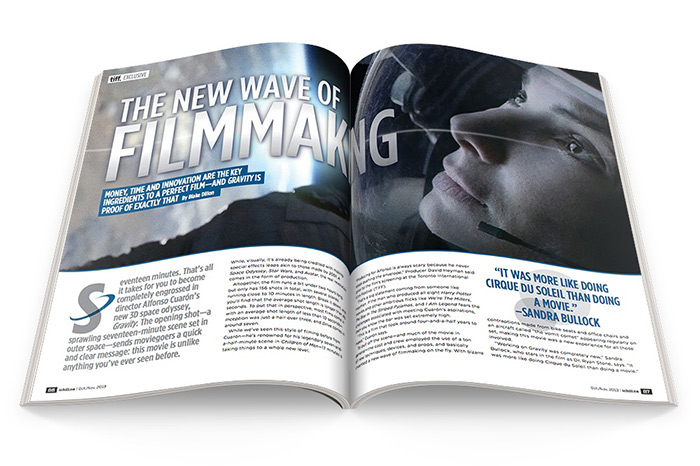
Seventeen minutes. That’s all it takes for you to become completely engrossed in director Alfonso Cuarón’s new 3D space odyssey, Gravity. The opening shot—a sprawling seventeen-minute scene set in outer space—sends moviegoers a quick and clear message: this movie is unlike anything you’ve ever seen before.
While, visually, it’s already being credited with making special effects leaps akin to those made by 2001: A Space Odyssey, Star Wars, and Avatar, the real revolution comes in the form of production.
Altogether, the film runs a bit under two hours long, but only has 156 shots in total, with several scenes running close to 10 minutes in length. Break it down, and you’ll find that the average shot length is longer than 46 seconds. To put that in perspective, most films come in with an average shot length of less than 10 seconds—Inception was just a hair over three, and Drive comes in around seven.
While we’ve seen this style of filming before from Cuarón—he’s renowned for his legendary seven-and-a-half-minute scene in Children of Men—17 minutes is taking things to a whole new level.
“Producing for Alfonso is always scary because he never stops pushing the envelope,” Producer David Heyman said prior to the film’s screening at the Toronto International Film Festival (TIFF).
That’s a big statement coming from someone like Heyman. If the man who produced all eight Harry Potter movies and other ambitious flicks like We’re The Millers, The Boy In The Striped Pyjamas, and I Am Legend fears the challenges associated with meeting Cuarón’s aspirations, then you know the bar was set extremely high.
“This is a film that took around four-and-a-half years to make,” Cuarón says.
To pull off the scene—and much of the movie in general—the cast and crew employed the use of a ton of new techniques, devices, and props, and basically invented a new wave of filmmaking on the fly. With bizarre contraptions made from bike seats and office chairs and an aircraft called “the vomit comet” appearing regularly on set, making this movie was a new experience for all those involved.
“Working on Gravity was completely new,” Sandra Bullock, who stars in the film as Dr. Ryan Stone, says. “It was more like doing Cirque du Soleil than doing a movie.”
Bullock’s character is a medical engineer on her first shuttle mission, accompanied by soon-to-be retired astronaut Matt Kowalski, played by George Clooney. During the mission, debris from a satellite crashes into the space shuttle, stranding them in space. In true Cuarón style, you’re sucked from tranquility to calamity in just a few short seconds.
The film is unique in that it had an $80-million budget, an all-star crew, and a lengthy production schedule, but features only two on-screen stars—and the majority of screen time belongs to Bullock alone. This tactic, Cuarón believes, is one that worked in their favour.
“Sandra really holds the film,” he says. “She just understood the themes of the story—adversity, growth, finding solutions, and rebirth.”
But the role didn’t come easy for Bullock. Between not being the first choice for the flick—Marion Cotillard, Scarlett Johansson, Blake Lively, and Natalie Portman were all approached before Bullock—and overcoming her fear of flying for shoots, she says she was forced to conquer a bit of adversity to pull it all off.
“I missed my son, I missed being with people, and I’m deathly afraid of flying,” she says. “But I love going outside of my comfort zone. Playing myself would be so boring.”
Bullock, Cuarón, and co. turned a simple sci-fi flick into a must-see masterpiece. And it’s a good thing they did. In the age of social media, where every single audience member is a critic, the expectations for Hollywood are higher than they’ve ever been, and filmmakers are taking note.
In the past year alone, we’ve seen flicks like The Hobbit, Django Unchained, Argo, and Zero Dark Thirty follow a similar formula to that of Gravity—and all of them were nominated for multiple Academy Awards.
This trend of dedicating large amounts of time and money to single projects like Gravity is netting filmmakers critical acclaim, and is surely something we’re about to see a lot more of.
Grab your popcorn.
